Scheduling a call center is a lot like bailing out a ship in troubled waters. There’s a high volume of calls constantly flowing into your business — and if you don’t assign enough agents to manage them, the number of frustrated customers builds up. Your best chance at keeping your business afloat is to answer calls more efficiently but, on days where there’s wave after wave, your team won’t be able to keep the flood at bay.
And it’s hard to predict when you’ll get a surge of calls or lose an employee ‘overboard’ and need extra cover.
All this means you can easily end up spending hours creating and amending timetables to keep your customers satisfied and avoid overloading staff.
That might be why you’re considering an app to make scheduling more efficient, maintain the necessary staffing levels, and achieve a high standard of customer service. Our article outlines the best call center scheduling software solutions based on their features, pricing, and customer reviews to help you make that decision.
Why do call centers need scheduling software?
Before we look at our selection of scheduling solutions and their features, let’s clarify what problems a call center manager might be trying to solve with them:
- Maintaining sufficient staffing levels: Call centers often get nonstop calls, and agents can only handle one at a time. That means it’s crucial to predict the number of staff you’ll need so customers won’t be kept waiting for too long.
- Accounting for availability: You probably have some early morning and evening hours to fill. Perhaps you even have night shifts to consider. As these hours are more likely to coincide with your team’s personal commitments, like family time and social events, you have to stay on top of their availability to prevent clashes and potential no-shows.
- Allocating shifts based on expertise: Agents often specialize in different business areas, for example, setting up a new account, organizing repairs, or granting refunds. But when you need to take different roles into account when scheduling, it adds an extra layer of complexity to the task.
- Spreading out undesirable shifts: Answering calls is mentally demanding. On top of that, call center hours often extend from the early morning into the middle of the night. To avoid burnout and maintain satisfaction, you have to make sure nobody gets too many long, busy, or inconvenient shifts in a row.
- Hiring the right candidates: Effective scheduling starts with recruitment. You need to find candidates whose availability matches the hours you’re trying to fill. Otherwise, you’ll find nobody’s free when you need to cover a shift.
Key features to look for in call center scheduling software
All scheduling platforms are different, but should ideally have the following:
- Forecasting tools: The key to steady profit, high customer satisfaction, and happy employees is consistent staffing levels. And instead of poring over old spreadsheets, you can use predictive tools to estimate how many employees you need and analytics to show your labor-to-sales ratios.
- Auto-population features: There’s no longer any need to drag and drop shifts into employee timetables. Platforms like Homebase can help you automatically create instant, foolproof schedules based on your team’s availability, preferences, and roles.
- Templates: When you have a schedule that works for your team, you can save and reuse it as many times as you like with Homebase. Or you can use it as the basis for a new timetable and just make a few tweaks.
- Self-scheduling tools: To give staff more autonomy over their hours, it’s ideal if you can let them arrange their own swaps and covers. All you have to do is approve.
- The ability to claim open shifts: This is a win-win for employees looking to earn some extra cash and managers who need to cover absences or undesirable shifts fast. You simply publish the hours you need to fill and team members can claim them.
- Chat capabilities: You need robust communication tools to coordinate swaps, send reminders, and approve claims for open shifts. The best scheduling software has built-in messaging features so you can dive straight into a chat with team members right in the app.
- Team availability management: Making sure you’ve got enough people to fill long work days can be tough. If you do it manually, you have to constantly check who’s free and willing to work in the evenings. Availability tools can save you time by letting team members update their free hours and notifying you when they’ve made the changes.
- A mobile app: Team members can have access to their schedules no matter where they are which means you can make adjustments to shifts without worrying about whether they get seen.
The breakdown: Top 8 call center scheduling software solutions
Here’s an overview of the call center scheduling software we think you should consider for your business:
1. Homebase: Best all-in-one solution
2. Shiftboard: Best for scheduling on-call employees
3. Connecteam: Best for categorizing teams
4. Humanity: Best for schedule visibility
5. Sling: Best for organizing early and late shifts
6. Deputy: Best for customizable settings
7. TixTime: Best for visualizing labor demand
8. Soon: Best for in-depth feedback
1. Homebase: Best all-in-one solution
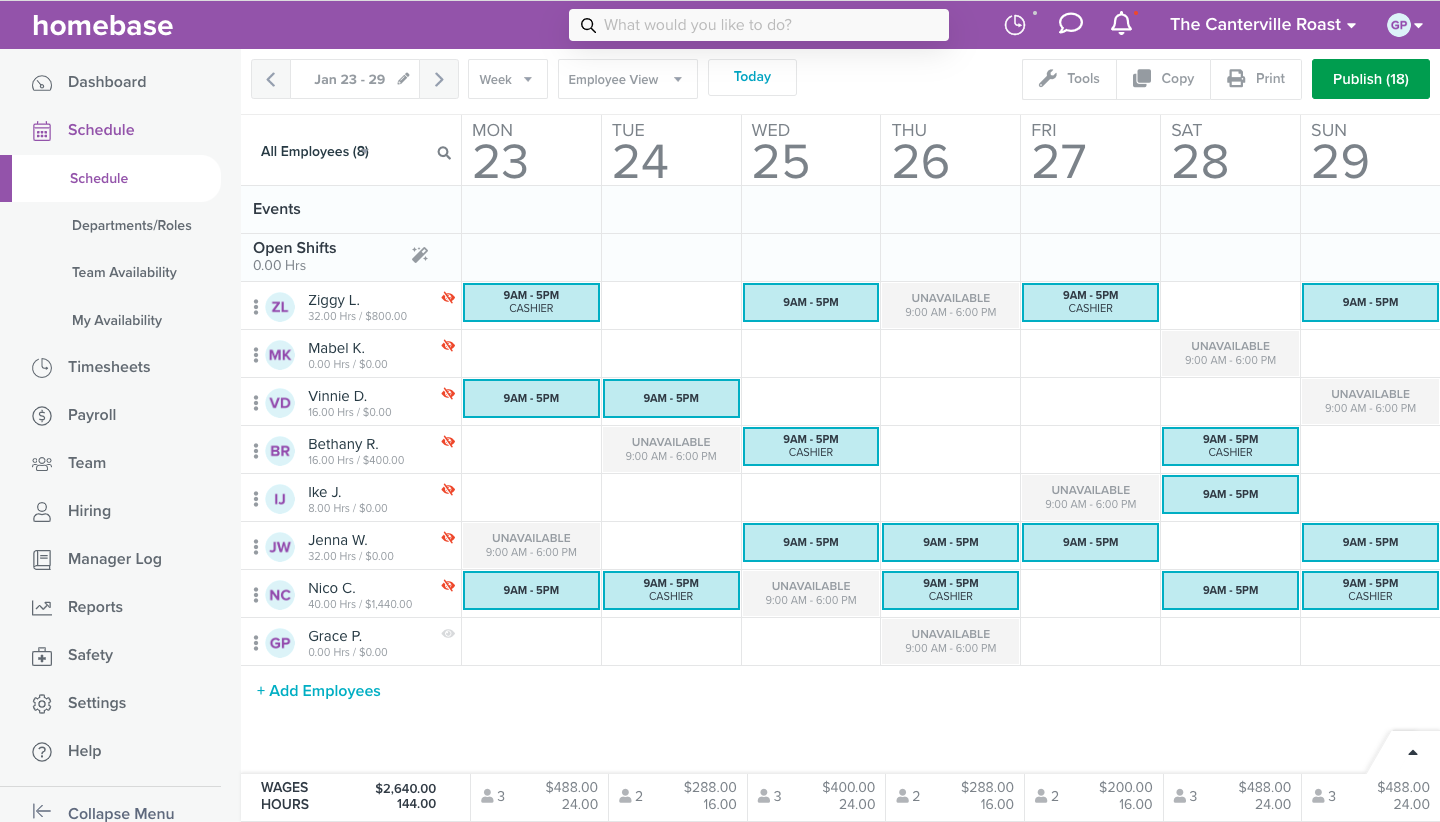
Homebase has a range of user-friendly tools to make scheduling more efficient while bearing in mind your labor demands and team availability.
Our range of scheduling tools gives you multiple ways to create speedy, error-free timetables. We have auto-scheduling features based on roles, departments, and availability — which you can collect easily by having your team update their free hours as they change. There’s also the option to save your best schedules as templates and simply retrieve them from the library with one click.
If you’ve made a couple of tweaks to automated or template schedules, there’s no need to worry about conflicts either. Homebase spots clashes and alerts you before you hit ‘publish’.
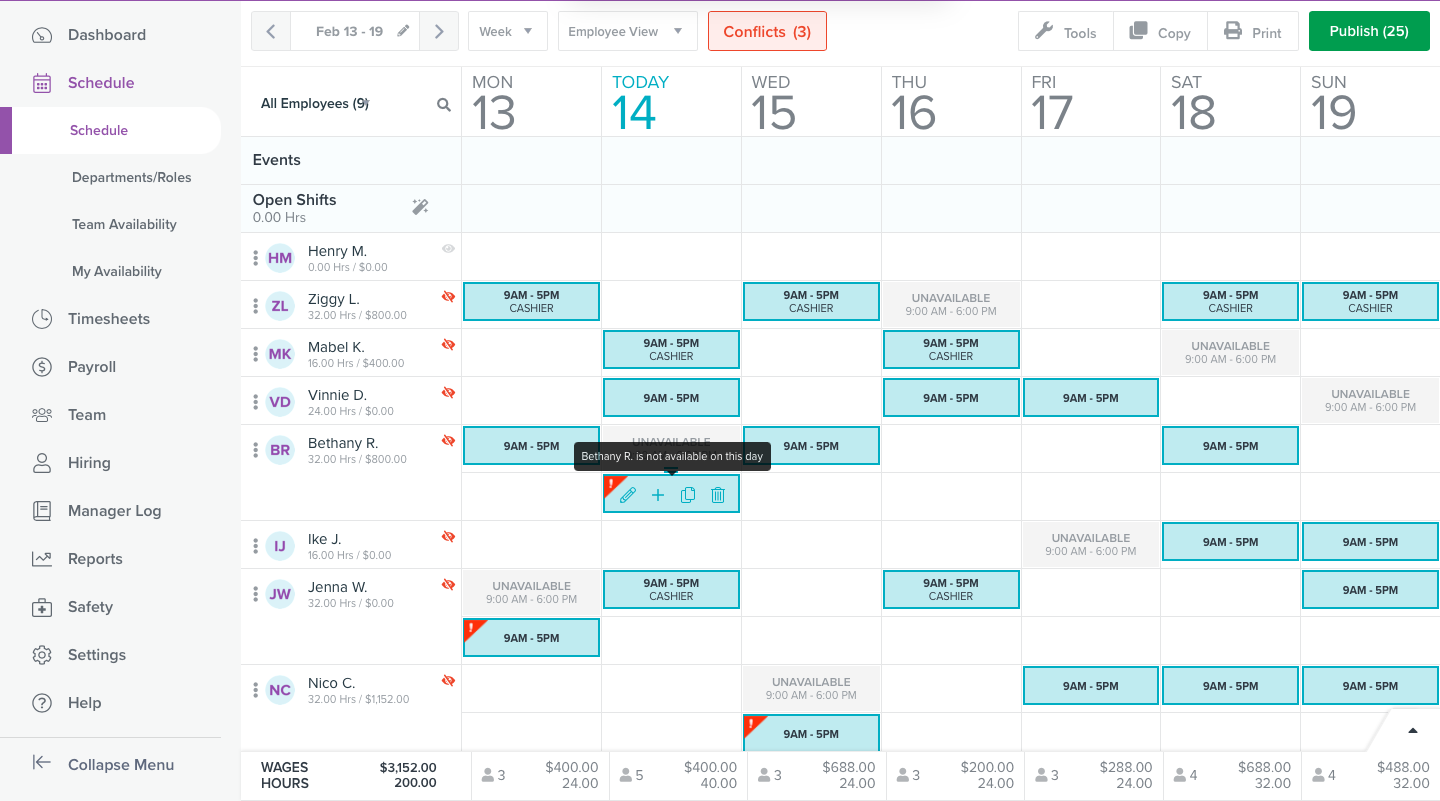
Employees also have the power to swap, find cover, or volunteer for extra hours with Homebase. This reduces scenarios where you have to call around to find free staff at peak call times or have staff hop on calls they’re not trained for.
While self-scheduling tools are useful, you’ll save more time if fewer swaps and covers were necessary in the first place. That’s why Homebase has robust hiring features so you hire candidates with availability that matches your call center hours. You can create job posts with the shift patterns from your template library and list them across hundreds of job sites to get the right candidates for the job.
Best of all, we have forecasting tools that analyze your historical labor data to suggest how many staff members you really need at work. Combined with our chat and shift feedback tools, you can develop a near-perfect understanding of how many roles you need for each shift. That means you won’t risk understaffing, putting teams under pressure, and lowering your standard of customer care.
Top features
- Schedules auto-populate based on roles, availability, and labor needs
- Reusable templates that are saved within an easily accessible library
- The ability for team members to claim open shifts
- Simple, effective employee self-scheduling tools
- Team communication app that can be used on desktop and mobile
- Shortcut to find cover for no shows
- Team availability management tools to easily collect times when employees can work
- Hiring and onboarding features
- Built-in time tracking, payroll, and HR and compliance features
Pros and cons
Pros
👍 Free plan
👍 All-in-one employee management solution
👍 Range of advanced scheduling tools
👍 Simple, fresh, intuitive design
👍 Designed for hourly teams
👍 Built-in time clock, payroll, and messenger
Cons
👎 Prioritizes features for small, hourly businesses
👎 May be unsuitable for international teams
Pricing
Homebase’s basic scheduling features are free for teams at one business location with twenty employees or fewer. We also offer three paid plans, but it’s worth noting most of our scheduling tools are available in Essentials, which is the lowest cost plan.
Here’s a breakdown of all the options we offer so you can make the most informed choice for your call center:
- Basic. Free for one location and up to 20 employees. It has basic schedule-building tools alongside time tracking, POS integrations, and email support.
- Essentials. $24.95 per month per location. Everything in Basic, plus advanced scheduling, performance tracking and time tracking tools, integrations with popular payroll apps, and access to live support.
- Plus. $55.95 per month per location. Everything in Essentials, plus hiring tools, time off controls, and departments and permissions.
- All-in-one. $99.95 per month per location. Everything in Plus, plus labor cost controls, business insights, HR and compliance, and onboarding tools.
Payroll is available as a separate add-on for $39 per month plus $6 per active employee. Customers can also commit to an annual plan and save 20% on their total cost.
What customers say
As of June 2023, Homebase has a 4.2/5 (100+ reviews) rating on G2 and a 4.6/5 (900+ reviews) rating on Capterra.
2. Shiftboard: Best for scheduling on-call employees
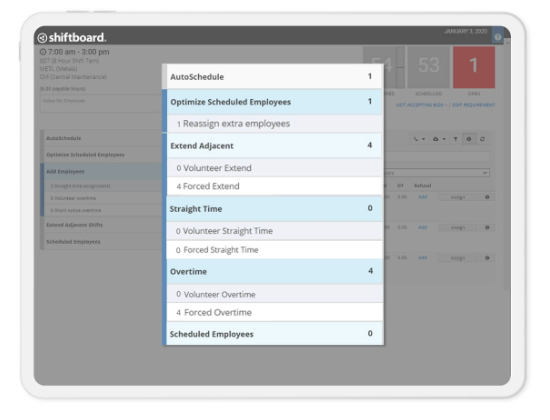
If you run a call center in the healthcare industry, your customers’ well-being may depend on your team. As a result, you may need to schedule on-call employees to ensure no call goes unanswered. In that case, Switchboard is a good option for you. This software solution lets you create a pool of backup workers with the right skills and assign them to be on standby.
Top features
- Automated scheduling based on roles, preferences, and availability
- Employee self-scheduling
- On-call scheduling
- Notifications about published and updated schedules
Pros and cons
Pros
👍 Comprehensive scheduling features
👍 Option to assign ‘on call’ shifts
Cons
👎 Inflexible pricing plans
👎 Specific to the manufacturing, warehouse, and healthcare industries
Pricing
Shiftboard has two plans with custom pricing, but they include all the same scheduling tools. Minimum fees apply.
What customers say
As of June 2023, Shiftboard has 4.5/5 (8 reviews) rating on G2 and 5/5 (1 review) rating on Capterra.
3. Connecteam: Best for categorizing teams

Depending on your industry, your agents may have a variety of skills, expertise, and experience. This can complicate scheduling based on different groups, as you can’t just assign shifts to anyone.
Connecteam has tags you can assign to groups and tasks that simplify scheduling. These tags make it easier to recognize when you have a sufficient number of certain roles. For example, you can see a specific shift requires at least one supervisor or two people with client retention experience and then allocate hours accordingly. You can also use tags to control other aspects of scheduling, like who gets visibility over what and whether swaps or covers get approval.
Top features
- Reusable schedule templates
- Open shifts
- Group, task, and visibility filters
Pros and cons
Pros
👍 Free plan available
👍 Highly customizable
👍 “Easy to install”
Cons
👎 “A lot of upgrades are required”
👎 Limits on users and locations
👎 “Time-consuming” to use all the features
Pricing
Connecteam offers a free plan for up to ten users. There are also three paid plans:
- Basic: $35 monthly and $0.60 per extra employee. Schedules for one location with task management, open shifts, and basic filters.
- Advanced: $59 monthly and $1.80 per extra employee. Schedules for up to three locations plus templates and advanced filters.
- Expert: $119 monthly and $3.60 per extra employee. Schedules for up to six locations plus sub-tasks and shift limitations.
There is also the option of custom pricing for businesses with more than six locations.
What customers say
As of June 2023, Connecteam has 4.3/5 (39 reviews) on G2 and 4.8/5 (220+ reviews) on Capterra.
4. Humanity: Best for schedule visibility
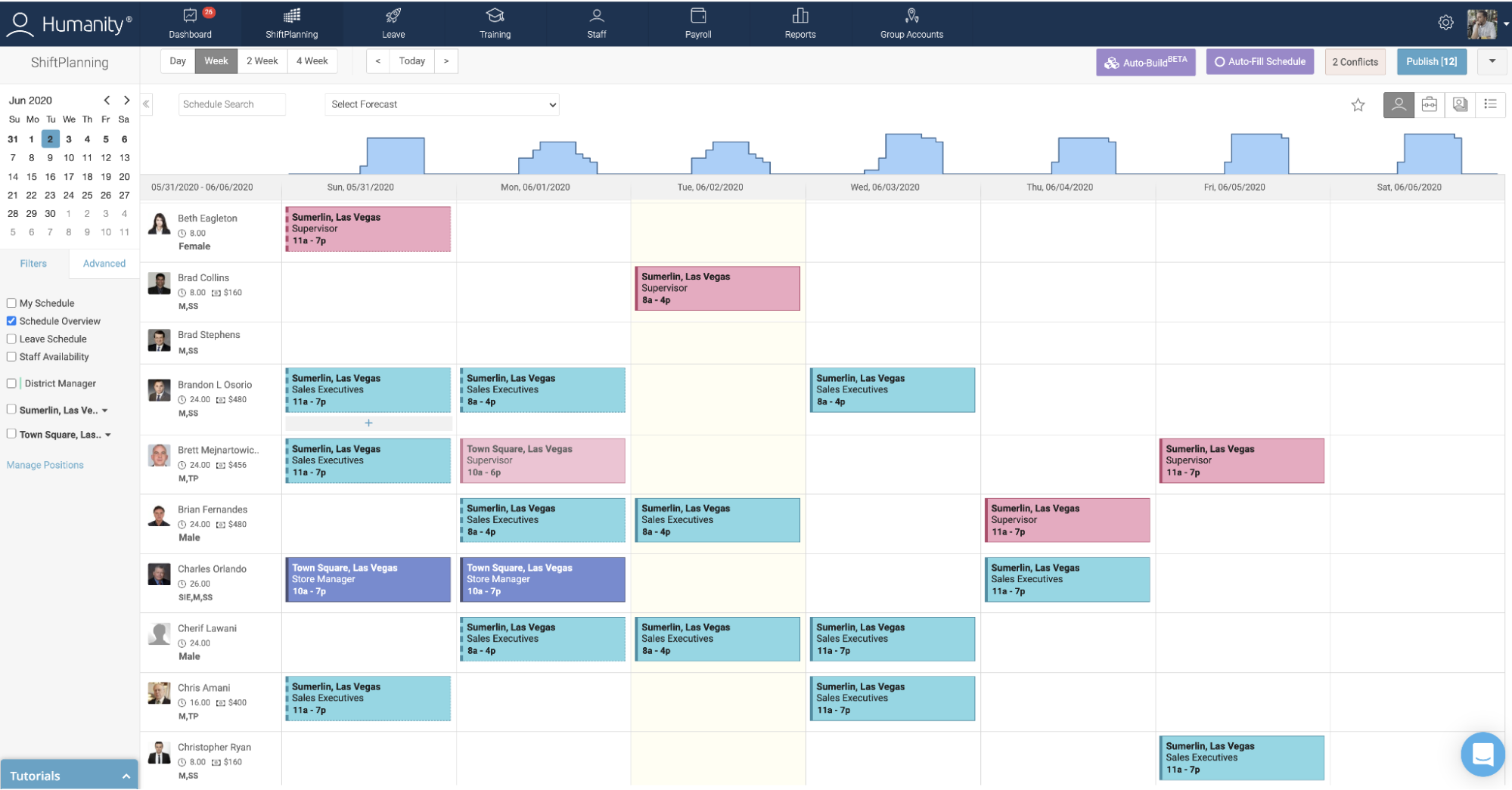
When you have a complex team with constantly changing shifts, making sense of schedules can be tricky. Humanity simplifies this by letting you view timetables based on:
- The day, week, two-week, or four-week period
- What the employee sees
- Each team member’s position
- Whether you want to see a grid or list format
Top features
- Automated scheduling
- A variety of views
- Custom templates and rules
- Employee self-scheduling
- Labor budgeting
Pros and cons
Pros
👍 Includes a plan for call centers
👍 “Easily apply for […] schedule swaps”
Cons
👎 Staff have “limited access” to schedules
👎 Specific to hybrid teams
👎 “A lot of clicking and waiting for things to load”
Pricing
Humanity has three paid plans with custom pricing:
- Starter, which has self-scheduling, a mobile app, and notifications.
- Classic, which has everything in Starter, plus automated scheduling, reporting, and compliance tools.
- Enterprise, which has everything in Classic, plus forecasting and integrations.
What customers say
As of June 2023, Humanity has a 4.3/5 (800+ reviews) rating on G2 and a 4.3/5 (200+ reviews) rating on Capterra.
5. Sling: Best for organizing early and late shifts
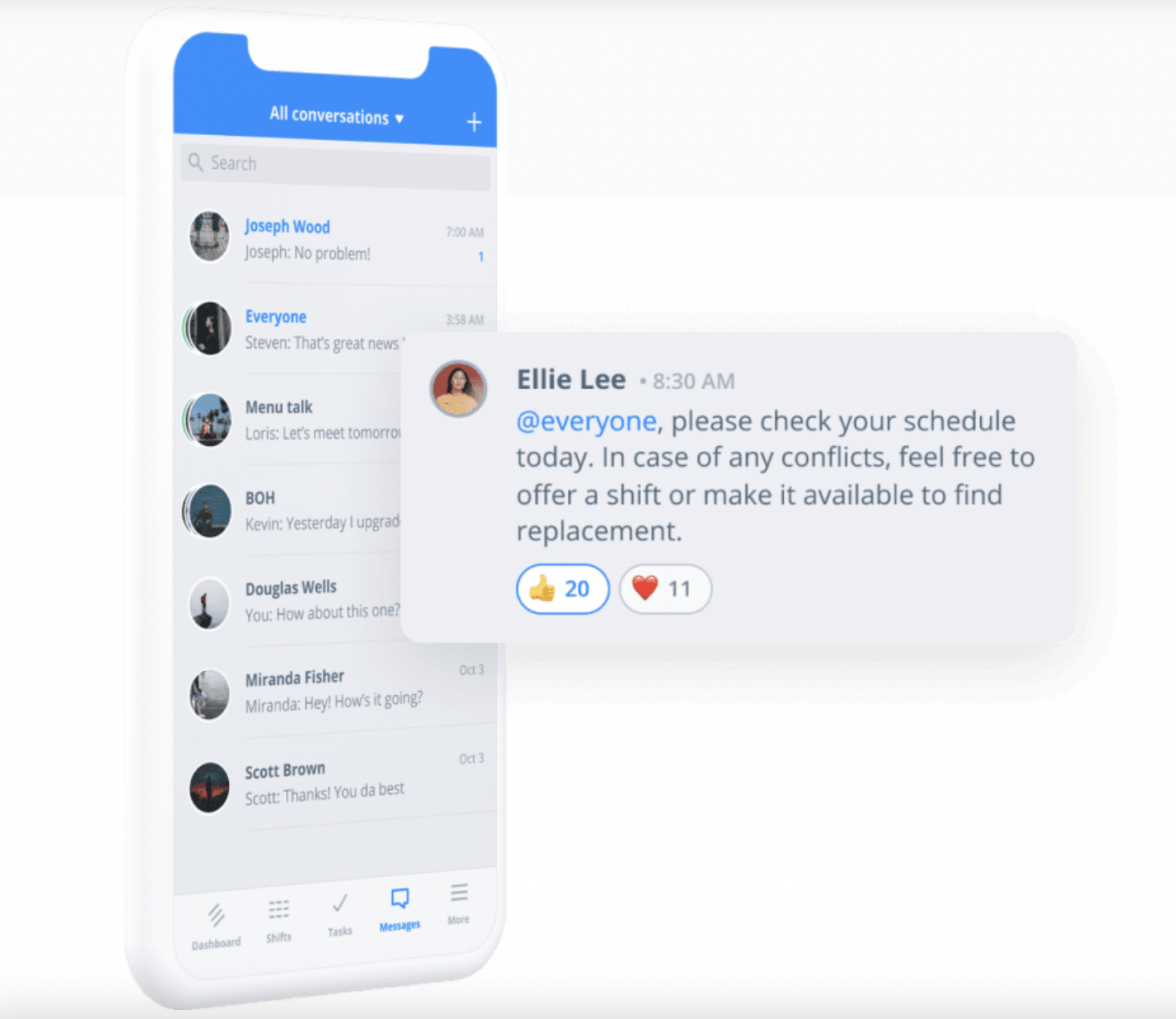
Classic timetable formats don’t give you a clear picture of how many 7 am starts or 10 pm finishes each employee has. This can lead to mistakes where staff members end up working too many undesirable shifts in a row and getting frustrated. But Sling lets you segment shifts into mornings, afternoons, and evenings to get extra clarity over timetables and avoid this problem.
Top features
- Schedule organization by morning, afternoon, and evening
- Team availability
- Automated scheduling
Pros and cons
Pros
👍 Free plan available
Cons
👎 Inflexible pricing plans
👎 Pay per employee
👎 Automated scheduling only in the highest cost plan
Pricing
Sling has a free plan with basic scheduling tools. There are also two paid plans:
- Premium at $2 per employee per month for everything in the free plan, plus templates and employee self-scheduling.
- Business at $4 per employee per month for everything in Premium, plus auto-scheduling and categorizing tools.
What customers say
As of June 2023, Sling has a 4.4/5 (80+ reviews) on G2 and a 4.6/5 (100+ reviews) rating on Capterra.
6. Deputy: Best for customizable settings
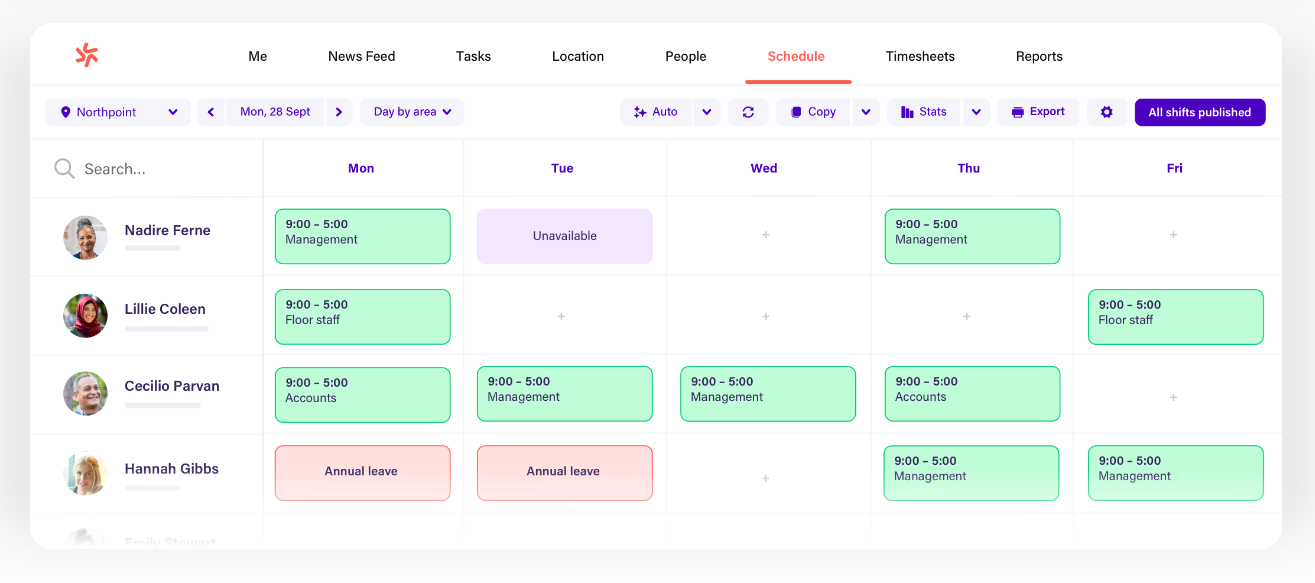
Every call center is different, so it stands to reason they won’t use the same kind of timetable. Deputy has a range of settings, so you can customize schedules to your specific team and working days. That means if you have unusual shift patterns or departments, perhaps due to having international customers, you won’t have to force your workflow into a standard template.
Top features
- Variety of settings
- Automated scheduling
- Email, website, and app notifications
Pros and cons
Pros
👍 “Easy to set up new employees”
Cons
👎 Inflexible pricing plans
👎 Pay per user may not be cost-effective for large teams
Pricing
Deputy offers one paid plan at $3.50 per user per month and it includes the full range of scheduling features. There’s also the option to add time tracking tools for $4.90 per user per month or request custom pricing if you have over 250 employees.
What customers say
As of June 2023, Deputy has a 4.6/5 (200+ reviews) rating on G2 and a 4.6/5 (600+ reviews) rating on Capterra.
7. Tixtime: Best for visualizing labor demand
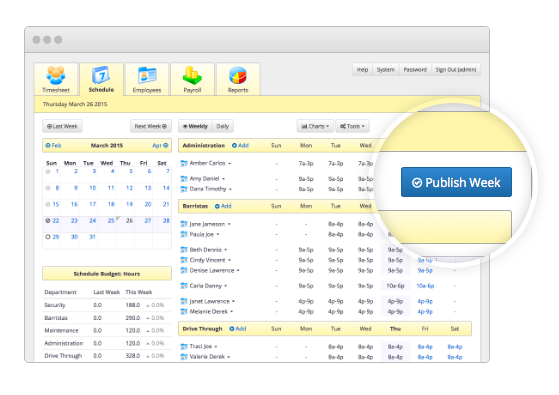
When you’re predicting labor demand, numbers alone may not give you the strongest sense of how each day can look. But Tixtime visualizes how many agents you’ll need on bar graphs. That way, you can spot trends and patterns more easily and link them to specific times or events. Say you’re a helpline for a software company — a boom in calls on Wednesday afternoons could indicate that’s when customers tend to use the product most.
Top features
- Automated scheduling
- Team availability
- Labor forecasting
- Data visualization
- Email and app notifications
Pros and cons
Pros
👍 Free plan available
👍 Labor forecasting data graphics
Cons
👎 Paid plans aren’t cost-effective for small teams
👎 Little information about tools available on the website
👎 Team availability is only in the highest cost plan
Pricing
Tixtime has a free plan for three teams. Otherwise, it offers three paid plans for up to 100 employees:
- Team at $379 per month for up to 3 teams. Includes basic scheduling tools.
- Business at $779 per month for up to 5 teams. Includes everything from Team plus break scheduling.
- Workforce at $1379 per month for up to 15 teams. Includes everything from Business plus team availability.
If you have more than 100 employees, you can contact Tixtime customer support for a custom quote.
What customers say
As of June 2023, Tixtime has no ratings on G2 and a 4.3/5 (3 reviews) rating on Capterra.
8. Soon: Best for in-depth feedback
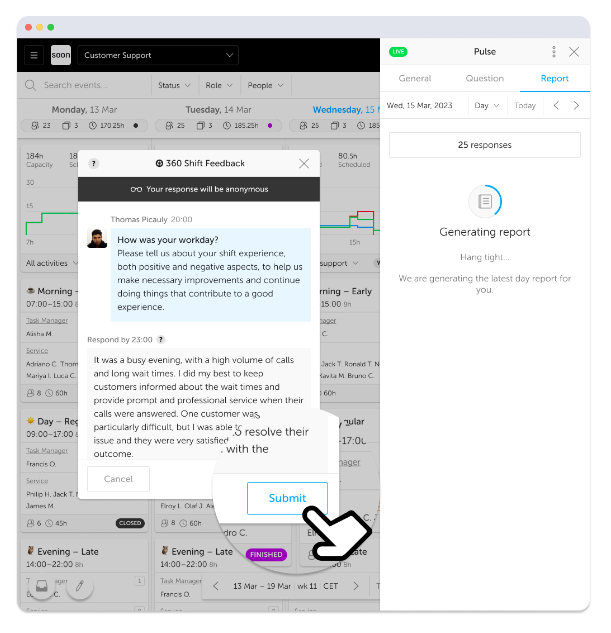
Historical labor data can only tell you so much. Low call numbers can hide a demanding shift that was full of difficult customers or complicated issues. That’s why Soon offers a shift feedback tool that lets you collect each staff member’s impression of their workday. As the responses are anonymous, you’ll get an honest account of how demanding each shift was, which makes it easier to decide how many employees you’ll need in the future.
Top features
- Shift feedback
- Task scheduling
- Employee self-scheduling
- Built-in chat
Pros and cons
Pros
👍 “Clear and concise workflow”
Cons
👎 Pricing per employee may not be cost-effective for large teams
👎 No option to be unavailable for half days
Pricing
According to GetApp, prices for Soon start at $9.
What customers say
As of June 2023, Soon has a 4.6/5 (16 reviews) rating on G2 and a 4.6/5 (40+ reviews) rating on Capterra.
But what’s the best call center scheduling software for you?
If you’re concerned about your call center being understaffed and your team capsizing under the pressure, you’re probably looking for a life raft. Call center scheduling software can help you maintain ideal staffing levels and get your business to dry land.
But call centers vary, so finding the best platform for your needs can take some digging. For example, Deputy may be ideal for large teams and Connecteam might be a good option for complex departments.
But in most cases, Homebase is the best all-around solution. Our blend of scheduling tools, forecasting, and availability features ensures you always have the employees you need, but never overstaff your business. With Homebase, it’s easier to coordinate shifts and arrange cover fast. That way, as many calls as possible get answered, all your customers are happy, and none of your team is stressed. Plus, with built-in time clock, timesheets, and payroll tools you get everything you need to manage and pay your team in one place.
